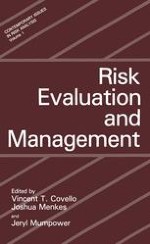1986 | OriginalPaper | Buchkapitel
Risk Evaluation
A Review of the Literature
verfasst von : Lloyd L. Philipson
Erschienen in: Risk Evaluation and Management
Verlag: Springer US
Enthalten in: Professional Book Archive
Aktivieren Sie unsere intelligente Suche, um passende Fachinhalte oder Patente zu finden.
Wählen Sie Textabschnitte aus um mit Künstlicher Intelligenz passenden Patente zu finden. powered by
Markieren Sie Textabschnitte, um KI-gestützt weitere passende Inhalte zu finden. powered by
The risk evaluation phase of risk analysis is concerned with the appraisal of the sociopolitical significance of an estimated risk. This significance may reflect its acceptability (or, in some instances, “tolerability,” when a risk exists that is not actually acceded to, but for whose mitigation no practicable approach is evident) or nonacceptability in relation to various possible criteria and/or as perceived by various groups. It may reflect the price paid in lost benefits if the risk is not accepted and the responsible hazardous activity is eliminated. Finally, it may reflect the costs required to mitigate the risk. This chapter reviews the literature on criteria or standards against which a hazardous activity’s risk can be decided to be acceptable or to require mitigation, and/or against which the residual risk of the mitigated hazard can be compared for acceptability. It is recognized, however, that the establishment of such criteria or standards suffers from severe difficulties, and that these difficulties underlie, at present, many decisions on highly beneficial but also highly hazardous activities in our society. Nuclear power is the paramount example; many others that have exercised Congress, regulators, activist groups, and the general public could also be noted.
